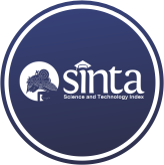Clustering Koridor Transjakarta Berdasarkan Jumlah Penumpang Dengan Algoritma K-Means
(1) Universitas Bina Sarana Informatika
(2) Universitas Bina Sarana Informatika
(3) Universitas Bina Sarana Informatika
(4) Universitas Bina Sarana Informatika
(*) Corresponding Author
Abstract
Full Text:
PDFReferences
Wikipedia, “Transjakarta.” [Online]. Available: https://id.wikipedia.org/wiki/Transjakarta. [Accessed: 25-Jan-2020].
D. Perhubungan, “Data Jumlah Penumpang Transjakarta,” Jakarta, 2018.
L. Zahrotun, “Analisis Pengelompokan Jumlah Penumpang Bus Trans Jogja Menggunakan Metode Clustering K-Means Dan Agglomerative Hierarchical Clustering (Ahc),” J. Inform., vol. 9, no. 1, pp. 1039–1047, 2015.
A. Hazman, F. T. Elektro, and U. Telkom, “Penerapan Metode K-Means Clustering Untuk Mengelompokkan Data Pelabuhan Dan Bongkar Muat Barang Di Indonesia,” e-Proceeding Eng., vol. 6, no. 1, pp. 1450–1454, 2019.
M. I. Firdaus, R. D. Octaviani, and I. Yusnita, “Clastering Calon Penumpang Kereta Cepat Jakarta-Bandung,” J. Manaj. Transp. DAN LOGISTIK, vol. 4, no. 2, p. 193, Sep. 2017.
S. Sukamto, I. D. Id, and T. R. Angraini, “Penentuan Daerah Rawan Titik Api di Provinsi Riau Menggunakan Clustering Algoritma K-Means,” JUITA J. Inform., vol. 6, no. 2, p. 137, 2018.
E. Dianawati, P. P. Yanti, and Y. Suryandari, “Klustering Jumlah Penumpang pada Halte Bus Rapid Transit Kota Tangerang,” J. Sist. Cerdas, vol. 2, no. 3, pp. 163–172, 2019.
K. Handoko and L. S. Lesmana, “Data Mining Pada Jumlah Penumpang Menggunakan Metode Clustering,” Snistek, no. 1, pp. 97–102, 2018.
F. Indriyani and E. Irfiani, “Clustering Data Penjualan pada Toko Perlengkapan Outdoor Menggunakan Metode K-Means,” JUITA J. Inform., vol. 7, no. 2, p. 109, 2019.
A. Supriyatna, I. Carolina, W. Widiati, and C. Nuraeni, “Rice Productivity Analysis by Province Using K-Means Cluster Algorithm,” IOP Conf. Ser. Mater. Sci. Eng., vol. 771, p. 012025, 2020.
G. Qiu, R. Song, S. He, W. Xu, and M. Jiang, “Clustering Passenger Trip Data for the Potential Passenger Investigation and Line Design of Customized Commuter Bus,” IEEE Trans. Intell. Transp. Syst., vol. 20, no. 9, pp. 3351–3360, 2019.
V. Adikariwattage, A. G. de Barros, S. C. Wirasinghe, and J. Ruwanpura, “Airport classification criteria based on passenger characteristics and terminal size,” J. Air Transp. Manag., vol. 24, pp. 36–41, 2012.
K. Handoko and L. S. Lesmana, “Pengelompokkan Data Mining Pada Jumlah Penumpang Di Bandara Hang Nadim,” Comput. Based Inf. Syst. J., vol. 6, no. 2, p. 60, 2018.
DOI: http://dx.doi.org/10.30645/j-sakti.v4i2.259
Refbacks
- There are currently no refbacks.
J-SAKTI (Jurnal Sains Komputer & Informatika)
Published Papers Indexed/Abstracted By:
Jumlah Kunjungan :



















